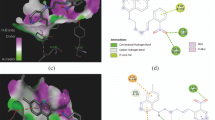Abstract
Some new 4-aminoquinoline derivatives were synthesized, characterized by their analytical and spectral data (IR, 1HNMR, 13CNMR and MS), and screened for in vitro antimalarial activity against a chloroquine-sensitive strain of Plasmodium falciparum (3D7). Results clearly reveal that all the synthesized compounds possess in vitro antimalarial activity at the tested dose which, however, was considerably less than that of the standard reference drug, chloroquine. From results, it could be assumed that the presence of an aromatic bulky group with optimal lipophilicity at 1,3-thiazinan-4-one ring system might be an important requirement for the antimalarial activity of synthesized compounds, 6a–g. In addition to the evaluation of antimalarial activity, the synthesized compounds were also screened for antibacterial activity against six different strains of Gram-positive (Bacillus subtilis, Bacillus cereus, and Staphylococcus aureus) and Gram-negative bacteria (Escherichia coli, Pseudomonas aeruginosa, and Klebsiella pneumoniae). All the compounds at the tested doses were found to be active against all the tested organisms, but were less active as compared to the standard drug, ofloxacin. Results of antibacterial study indicate that aromatic bulky substituents have greater contributing effect than the aliphatic non-bulky group toward the antibacterial activity of the prepared 4-aminoquinoline derivatives.


Similar content being viewed by others
References
Casteel DA (2003) Antimalarial agents. In: Abraham DJ (ed) Burger’s medicinal chemistry and drug discovery, 5th edn. Wiley Interscience, New York, p 920
Chiang PK, Bujnicki JM, Su S, Lanar DE (2006) Malaria: therapy genes and vaccines. Curr Mol Med 6(3):309
Chou AC, Chevli R, Fitch CD (1980) Ferriprotoporphyrin IX fulfills the criteria for identification as the chloroquine receptor of malaria parasites. Biochemistry 19:1543–1549
Collee JG, Duguid JP, Fraser MG, Marmion BP, McCartney M (1989) Practical medical microbiology, 13th edn. Churchill Livingstone, London
Dorn A, Stoffel R, Matile H, Bubendorf A, Ridley RG (1995) Malarial hemozoin/β-hematin supports haem polymerization in the absence of protein. Nature 374:269–271
Egan TJ, Marques HM (1999) The role of haem in the activity of chloroquine and related antimalarial drugs. Coord Chem Rev 190–192:493–517
Farooq U, Mahajan RC (2004) Drug resistance in malaria. J Vector Borne Dis 41:45
Foley M, Tilley L (1998) Quinoline antimalarials: mechanism of action and resistance and prospects for new agents. Pharmacol Ther 79(1):60–67
Gillies HM (2000) Management of severe malaria: a practical handbook, 2nd edn. WHO, Geneva
Goker H, Kus C, Boykin DW, Yildiz S, Altanlar N (2002) Synthesis of some new 2-substituted-phenyl-1H-benzimidazole-5-carbonitriles and their potent activity against Candida species. Bioorg Med Chem 10:2589–2596
He Y, Wu B, Yang J, Robinson D, Risen L, Ranken R, Blyh L, Sheng S, Swayze EE (2003) 2-Piperidin-4-yl-benzimidazoles with broad spectrum antibacterial activities. Bioorg Med Chem Lett 13:3253–3256
Hewitt W (2004) Microbiological assay for pharmaceutical analysis: a rational approach. Interpharm/CRC, New York
Lambros C, Vanderberg JPJ (1979) Synchronization of Plasmodium falciparum erythrocytic stages in culture. Parasitology 65:418–420
Madrid PB, Wilson NT, DeRisi JL, Guy RK (2004) Parallel synthesis and antimalarial screening of a 4-aminoquinoline library. J Comb Chem 6:437–442
Pandey AV, Bisht H, Babbarwal VK, Srivastava J, Pandey KC, Chauhan VS (2001) Mechanism of malarial haem detoxification inhibition by chloroquine. Biochem J 355:333–338
Ridley R (2002) Medical need, scientific opportunity and the drive for antimalarial drugs. Nature 415:686–693
Silverstein RM, Webster FX (2005) Spectrometric identification of organic compounds, 6th edn. Wiley, New York
Solomon VR, Haq W, Srivastava K, Puri SK, Katti SB (2005) Design and synthesis of new antimalarial agents from 4-aminoquinoline. Bioorg Med Chem 13:2157–2165
Solomon VR, Puri SK, Srivastava K, Katti SB (2007) Synthesis and antimalarial activity of side chain modified 4-aminoquinoline derivatives. J Med Chem 50:394–398
Sullivan DJ, Gluzman IY, Russell DG, Goldberg DE (1996) On the molecular mechanism of chloroquine’s antimalarial action. Proc Natl Acad Sci USA 93:11865–11870
Talisuna AO, Loland P, Alessandro UD (2004) History, dynamics, and public health importance of malaria parasite resistance. Clin Microbiol Rev 17(1):236
Tilley L, Loria P, Foley M (2001) Chloroquine and Other Quinoline Antimalarials. In: Rosenthal PJ (ed.) Antimalarial Chemotherapy: mechanisms of action, resistance, and new directions in drug discovery. Humana, New Jersey, pp 89–99, pp 103–105
Trager W, Jensen JB (1976) Human malaria parasites in continuous culture. Science 193:673–675
White WJ (2008) Plasmodium knowlesi: the fifth human malaria parasite. Clin Infect Dis 46:172
Wiesner J, Ortmann R, Schlitzer M (2003) New antimalarial drugs. Angew Chem Int Ed Engl 42:5274
World Health Organization (1998) http://www.rbm.who.int/ what is malaria? Roll back malaria. World Health Organization, Geneva. Accessed 25 April 2009
Acknowledgments
The authors thank M/s Mangalam Drugs & Organics Ltd., Mumbai, for supplying gift sample of 4,7-dichloroquinoline; Director, SAIF, NEHU, Shillong, for recording the spectral data of the compounds, and Dr. J. Mahanta, Director, R M R C (I C M R), N E Region, Dibrugarh, for providing antimalarial screening facility. Technical assistance provided by Mr. B. K. Goswami, Mr. Devojit Kr. Sarma, and Dr. Kanta Bhattacharya, in antimalarial screening is gratefully acknowledged.
Author information
Authors and Affiliations
Corresponding author
Rights and permissions
About this article
Cite this article
Rudrapal, M., Chetia, D. & Prakash, A. Synthesis, antimalarial-, and antibacterial activity evaluation of some new 4-aminoquinoline derivatives. Med Chem Res 22, 3703–3711 (2013). https://doi.org/10.1007/s00044-012-0371-9
Received:
Accepted:
Published:
Issue Date:
DOI: https://doi.org/10.1007/s00044-012-0371-9




